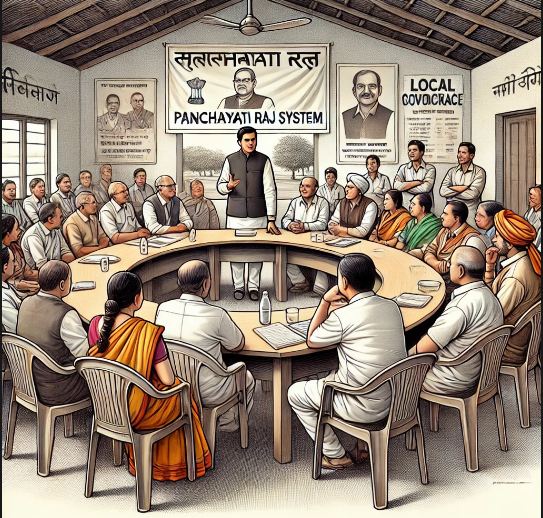The Panchayati Raj system in India has a long history rooted in traditional self-governance practices. The system evolved over centuries and was institutionalized in independent India to decentralize power and empower local self-governments. Below is a detailed overview of its history:
Ancient Period
- Village Assemblies: Ancient texts like the Rigveda and Arthashastra mention self-governed village assemblies (sabhas and samitis).
- Chola Dynasty: In Southern India, especially during the Chola period (9th–13th centuries), well-structured local self-governments flourished. Village assemblies (known as ur, sabha, or nadu) managed local affairs.
Medieval Period
- Local self-governance weakened under centralized monarchies and the feudal system during the medieval period.
- However, in some regions, village communities retained autonomy in managing resources and resolving disputes.
British Period
- Decline of Panchayats: The British introduced centralized administration, which weakened traditional Panchayati systems.
- Mayo’s Resolution (1870): Lord Mayo introduced local self-government at the district level, marking the beginning of decentralization.
- Lord Ripon’s Resolution (1882): Called the “father of local self-government in India,” Ripon proposed reforms to strengthen local bodies, including village councils. However, these reforms were largely restricted to urban areas.
- Government of India Act, 1919: Provided a framework for rural self-governance but had limited impact.
- Government of India Act, 1935: Gave more autonomy to provinces to structure local governments.
Post-Independence Period
- Constitutional Vision (1948–1950):
- The drafting of the Indian Constitution included debates on Panchayati Raj.
- Article 40 in the Directive Principles of State Policy emphasized that states should organize village panchayats to function as units of self-government.
- Early Experiments: Many states experimented with Panchayati Raj institutions (PRIs) in the 1950s.
Balwant Rai Mehta Committee (1957)
- Appointed to examine the Community Development Programme (1952) and National Extension Service (1953).
- Recommended the three-tier structure of Panchayati Raj:
- Village Level: Gram Panchayat
- Block Level: Panchayat Samiti
- District Level: Zila Parishad
- Suggested democratic decentralization, with elected bodies at all levels.
- The system was first implemented in Rajasthan (1959) at Nagaur and later in Andhra Pradesh.
Ashok Mehta Committee (1977)
- Recommended replacing the three-tier system with a two-tier system (Zila Parishad and Mandal Panchayat).
- Emphasized the need for constitutional protection for PRIs.
- Advocated for the inclusion of political parties in Panchayat elections.
- The recommendations were not fully implemented.
73rd Constitutional Amendment Act (1992)
This was a landmark moment in the history of Panchayati Raj in India, institutionalizing it as the third tier of governance.
Key Provisions:
- Three-Tier Structure:
- Gram Panchayat: Village level.
- Panchayat Samiti: Intermediate level (block).
- Zila Parishad: District level.
- Elections:
- Direct elections to all levels every five years.
- Reservation:
- Seats reserved for Scheduled Castes (SCs), Scheduled Tribes (STs), and women (33%, now 50% in many states).
- Powers and Responsibilities:
- Preparation of plans for economic development and social justice.
- Implementation of schemes for 29 subjects listed in the 11th Schedule.
- State Election Commission:
- Independent body to conduct Panchayat elections.
- State Finance Commission:
- Reviews the financial position of PRIs every five years.
First Implementation:
- After the amendment, elections were held across India in 1994–1995.
Present Status
- Empowerment: PRIs now play a crucial role in rural development, implementing flagship schemes like MGNREGA and Swachh Bharat Mission.
- Challenges:
- Limited financial autonomy.
- Political interference.
- Lack of capacity and awareness among elected representatives.
- Reforms: Efforts are ongoing to strengthen PRIs through digitalization, capacity-building programs, and fiscal decentralization.
The Panchayati Raj system has been instrumental in decentralizing governance, ensuring grassroots participation, and fostering rural development in India.


